

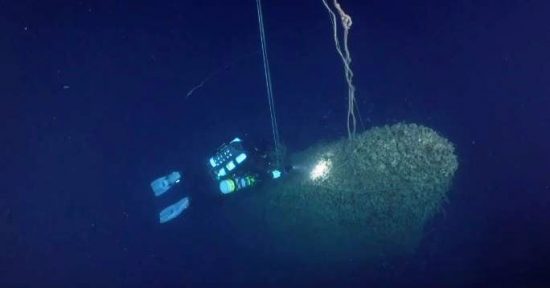
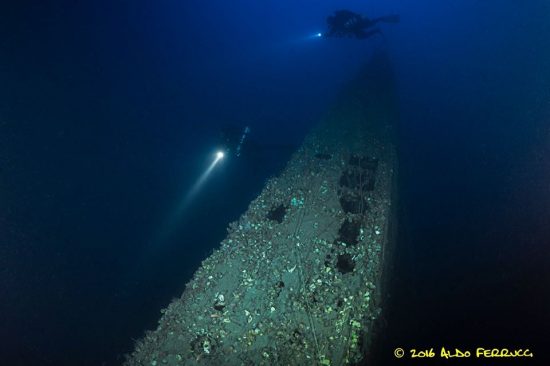
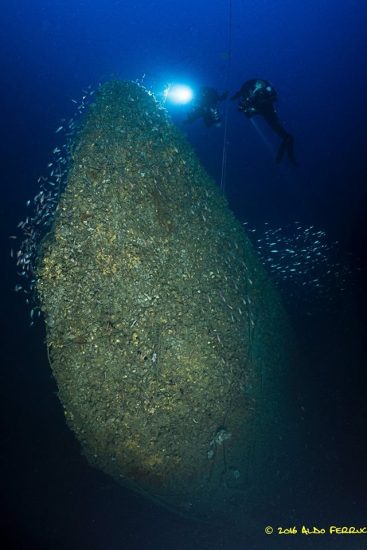
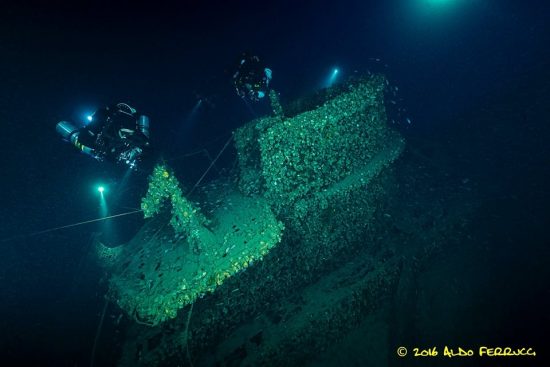

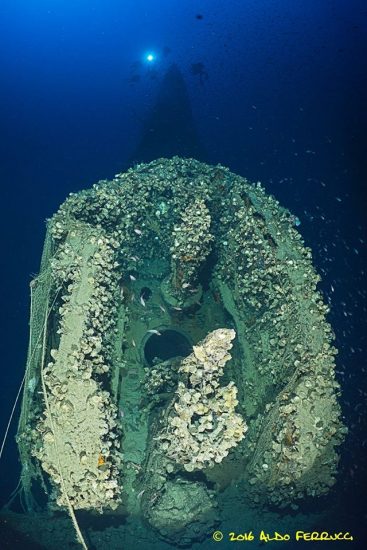
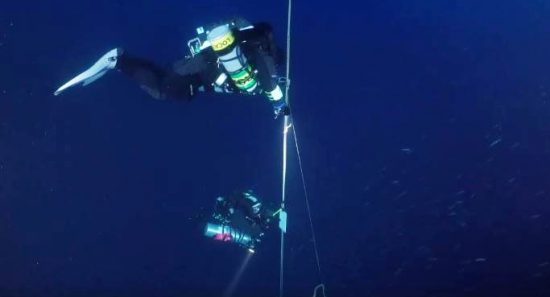
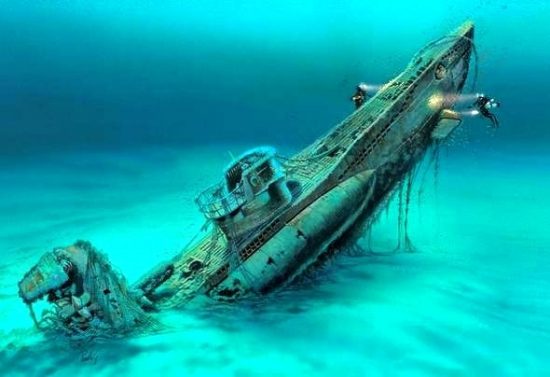
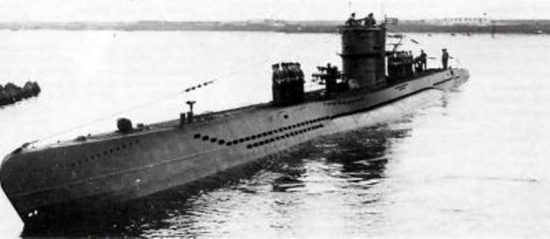

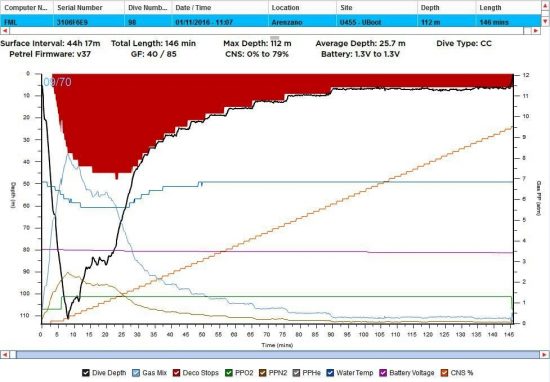
Early in the morning, the 300 horsepower engine of the 8m superfast inflatable boat flies us over a mirror-like sea towards the wreck’s position. It takes us less than 30 minutes to arrive from the port of Arenzano.
No useless searching; experience and GPS lead us immediately to the site.
We grab the underwater hidden descent line from below the water and attach it to our boat. We start to gear up with the assistance of safety diver Luca Parodi.
There are 3 of us: Aldo Ferrucci, Andrea Bada and I. Our planned dive zone is 90m - 120m. All three of us are diving with rebreathers using hypoxic trimix or heliox diluents, and we each carry 3 bailout tanks.
Most of the equipment is Mares│XR as we are not only here to enjoy the dive but also test products.
We hit the water at 11am, do a 6m classic bubble check and slowly go down.
The highest part of the submarine can be reached at 88m; we switch set points and continue to go down. The sand bed is at 118m but we don’t reach it as we are truly fascinated by this incredible wreck.
The submarine is in perfect shape, and around three quarters of its length is standing upright, literally planted in the sand, sitting at a 45° angle to the surface.
We start from the pole and fly over ballast left on the bottom to start the ascent. We see the bridge, the gun holder and the open hatch leading inside the submarine and up the booth to the periscope.
At the foot of the kiosk, there is the magnetic compass and the bridge that goes forward from there. We switch on the side to go under the submarine.
The sight of this whole submarine overlooking us is incredible.
We go to the other side - avoiding the nets that hang from the hull - to admire the anchor still attached above the two tiller bars.
The wreck is surrounded by thousands of fish (Anthias anthias) in schools so numerous that we can touch them, and in the holes some beautiful lobsters and fat moray eels are watching us.
Run time is now 22 minutes, it’s time to leave. We sign the off-site plate at 85m, which is one of our mandatory safety checks, and then the very long way up starts.
We reach the 50m safety tank and take it back with us, then the 21m one and finally wait for long at the deco station with decompression bars installed by Luca at 9m, 6m and 3m again surrounded by other safety tanks.
Safety and organization are key factors in the success of such a dive, and for that Techdive is definitely one of the best dive bases.
There is no current and we enjoy these long deco minutes. It is also a good time and place to eat and rehydrate.
Nevermind the wait, once again we have filled our heads and eyes with images and memories.
A bit of history:
This Type VIIC submarine was built in Kiel (Werk 286) by Deutsche Werke AG to reinforce the fleet of Kriegsmarine attacking submarines.
Ordered on the 16th January 1940, this sea wolf was ready on the 3rd September 1940, launched on the 21st June 1941 and commissioned on the 21st August 1941 to Kptlt. Hans-Henrich Giessler who later - on the 22nd November 1942 - passed commands to Kptlt. Hans-Martin Scheibe.
The crew was made up of 51 personnel.
Type VIIC were preceded by the shorter Type VIIB submarines. U-455 had a displacement of 769 tons when at the surface and 871 tons while submerged. It had a total length of 67.10m, a pressure hull length of 50.50m, a beam of 6.20m, a height of 9.60m and a draught of 4.74m.
The submarine was powered by two Germaniawerft F46 four-stroke, six-cylinder supercharged diesel engines producing a total of 2,800 to 3,200 metric horsepower for use while surfaced and two Siemens-Schuckert GU 343/38–8 double-acting electric motors producing a total of 750 metric horsepower for use while submerged. It had two shafts and two 1.23m propellers. The boat was capable of operating at depths of up to 230 metres.
As a true war machine, U-455 was fitted with five 53.3cm (21in) torpedo tubes (four fitted at the bow and one at the stern), fourteen torpedoes, one 8.8cm (3.46in) SK C/35 naval gun, 220 rounds and an anti-aircraft gun. The boat had a complement of between forty-four and sixty people.
The U455 operated as a part of a wolf pack. This German WW2 tactic was to use a pack of submarines to attack ships or convoys of allied ships together from all sides at the same time, and be able to fire torpedoes over a long period of time.
The submarine had a short career of only a few Wolfpack operation patrols: Hech, Pfadfinder, Draufgänger, one without a name and Schlieffen.
The U455 only had a few successes: 3 ships sunk, 2 British and 1 French, for a total tonnage of 17,685 GRT.
On March 28th 1944, the U455 was still communicating and was reported for the last time on 2nd April 1944 while returning from its patrol area off Algiers. A few days later, silence was the only answer on the radio.
The U455 was sunk on 6th April 1944 in the Mediterranean Sea south-east of Genoa, in position 44.18,6N, 09.02,9E, by a mine in the German barrage Fuss-Ball-Klub.
The German navy did not provide the sub's captain with their latest minefield maps and U-455 was driven straight into a German minefield. A mine exploded near the stern section - possibly during a turn - ripping off about 10m (33ft) of the boat's stern, leaving the crew without any chance of survival. The boat was likely at periscope depth, since the observation mast was deployed. 51 died (all were lost).
The wreck was discovered by Lorenzo del Veneziano on 23rd October 2005 at a depth of 120m off Portofino, Italy.
All underwater photos are kindly provided by Aldo Ferrucci.
A word of warning:
This is deep mixed hypoxic gas rebreather technical diving and you should not attempt this type of diving unless properly trained and – even more importantly - having sufficient, real and truly significant experience to carry out these dives.
Recommendations:
For the complete technical diving set of gear, our best and only choice is Mares│XR.
For all technical training, I recommend the Scuba Schools International (SSI) programs and particularly the SSI XR programs.
For rebreathers, one of the best options is rEvo.
For scooters, our partner of choice is Suex.
Last but not least, nothing would have been possible without the support of Techdive Arenzano, our favorite extreme technical diving facility in the area.
 Florent M. Locatelli
Florent M. Locatelli 4th November 2016
4th November 2016 Arenzano, Gênes, Italie
Arenzano, Gênes, Italie 
